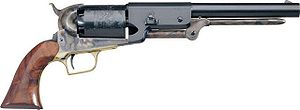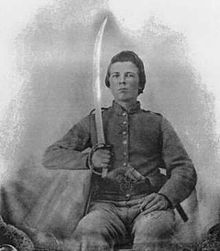- Colt Walker
-
Colt Walker 
Colt Walker Model 1847Type Revolver Place of origin  United States
United StatesService history In service 1847-48 then evolved into subsequent designs Used by U.S. Production history Designer Samuel Colt, Captain Samuel Walker Designed 1847 Manufacturer Eli Whitney, Jr. at Whitneyville, Connecticut for Colt Firearms Produced 1847 Number built 1,100 Variants Colt Whitneyville Hartford Dragoon Revolver, quantity about 240 Specifications Weight 4.5lb (2.06 kg) Length 15.5 inch Caliber .44 ball, revolver (.454 in., dia.) Action single-action Muzzle velocity 1,000-1,200+ feet per second Effective range 100 yards Feed system six-round cylinder Sights blade front sight, hammer notch rear sight The Colt Walker is a single action revolver with a revolving cylinder holding six charges of black powder behind six bullets. It was designed in 1846 as a collaboration between Captain Samuel Hamilton Walker and American firearms inventor Samuel Colt.
Contents
History
The Colt Walker was the largest and most powerful black powder repeating handgun ever made. It was created in the mid-1840s in a collaboration between Captain Samuel Hamilton Walker (1817–47) and American firearms inventor Samuel Colt (1814–62), building upon the earlier Colt Paterson design. Walker wanted a handgun that was extremely powerful at close range.[1]
Samuel Walker carried two of his namesake revolvers in the Mexican–American War.[2] He was killed in battle the same year that his famous handgun was invented, 1847, shortly after he had received them. Only 1100 of these guns were originally made, which makes originals extremely difficult and expensive to obtain. On October 9, 2008, one specimen that had been handed down from a Mexican War veteran sold at auction for US$920,000.[3]
The Republic of Texas had been the major purchaser of the early Paterson Holster Pistol (No. 5 model), a five shot cal .36 revolver, and Samuel Walker became familiar with it during his service as a Texas Ranger. In 1847, Walker was engaged in the Mexican-American War as a captain in the United States Mounted Rifles. He approached Colt, requesting a large revolver to replace the single-shot Aston Johnson holster pistols then in use. The desired .44-.45 caliber revolver would be carried in saddle mounted holsters and would be large enough to dispatch horses as well as enemy soldiers. The Colt Walker was used in the Mexican-American War and on the Texas frontier.[1]
Medical officer John "R.I.P" Ford took a special interest in the Walkers when they arrived at Vera Cruz. He obtained two examples for himself and is the primary source for information about their performance during the war and afterward. His observation that the revolver would carry as far and strike with the same or greater force than the .54 caliber Mississippi Rifle seems to have been based on a single observation of a Mexican soldier hit at a distance of well over one hundred yards. The Walker, unlike most succeeding martial pistols and revolvers, was a practical weapon out to about 100 yards.[1]
Specifications
The Colt Walker holds a powder charge of 60 grains (3.9 g) in each chamber, more than twice what a typical black powder revolver holds. It weighs 4½ pounds (2 kg) unloaded, has a 9-inch (229 mm) barrel, and fires a .44 caliber (0.454 in, 11.53 mm diameter) conical and round ball. The initial contract called for 1,000 of the revolvers and accouterments. Colt commissioned Eli Whitney Junior to fill the contract and produced an extra 100 revolvers for private sales and promotional gifts.[4]
Problems
In addition to its large size and weight, problems with the Walker included ruptured cylinders after firing. This has been attributed to primitive metallurgy, soldiers allowing powder to spill across the mouths of the chambers, and even loading the original conical bullets backwards into the chambers. Under 300 of the original 1,000 were returned for repair due to a ruptured cylinder. Lard was loaded into the mouths of the cylinders on top of each bullet after loading to prevent the spark from igniting all chambers at once, a practice which continues to this day among blackpowder revolver shooters and although each chamber held 60 grains of Powder, Colt recommended no more than 50 grains in each.[5]
The Walker had an inadequate loading lever catch that often allowed the loading lever to drop during recoil, preventing fast follow-up shots. Period-correct fixes for this often included placing a rawhide loop around both the barrel and loading lever, to prevent the loading lever from dropping under recoil and locking the action.[6]
Legacy
The Whitneyville-Hartford Dragoon is known as the first transitional model from the Walker to the Dragoon series, as it was largely built from leftover Walker parts. Subsequent contracts beginning in 1848 followed, for what is today known among collectors as the 1st Dragoon, 2nd Dragoon, and 3rd Colt Dragoon Revolver models that were all based on the Walker Colt, enabling a rapid evolution of the basic revolver design. These improvements included 71⁄2-inch (190 mm) barrels, shorter chambers, typically loaded only to 50 grains instead of 60 grains, thereby reducing the occurrence of ruptured cylinders, and the addition of a positive catch at the end of the loading lever to prevent the dropping of the loading lever under recoil.[1]
The Colt Walker was quite powerful, with modern replicas firing modern FFFg black powder producing energy levels in excess of 500 foot pounds with both picket bullets and 0.454-inch-diameter (11.5 mm), 141-grain (9.1 g) round ball bullets. The black powder Colt Walker is regarded as the most powerful commercially manufactured repeating handgun from 1847 until the introduction of the .357 Magnum in 1935, and has a muzzle energy nearly exactly the same as a 4-inch-barreled handgun firing a .357 Magnum.[7] The Colt Walker has long maintained a unique position and mystique among handgun users, and its name is often used as a common expression of any overly large generic handgun example.
Modern replicas have been offered by the Colt Blackpowder shop and Uberti Firearms.[8]
References
- ^ a b c d Rick Sapp (2007). Standard Catalog of Colt Firearms. F+W Media, Inc,. pp. 35–40. ISBN 9780896895348.
- ^ The Handbook of Texas Online The Handbook of Texas Online entry for Samuel Hamilton Walker. Accessed on 2007-05-12.
- ^ "Colt Walker pistol hits record $920,000 at James Julia auction". Auction Central News. Live Auctioneers LLC. 28 October 2008. http://acn.liveauctioneers.com/index.php/features/antiques/36-antiques/258-colt-walker-pistol-hits-record-920000-at-james-julia-auction. Retrieved 2008-11-20.
- ^ Flayderman, Norm (2001). Flayderman's Guide to Antique American Firearms... and their values. Iola, WI: Krause Publications. p. 669. ISBN 0-87349-313-3.
- ^ Cumpston, Mike (2005). Johnny Bates. ed. Percussion Pistols and Revolvers: History, Performance and Practical Use. iUniverse. p. 80. ISBN 9780595357963.
- ^ John Taffin. Gun Digest Book of the .44. p. 12. ISBN 0896894169.
- ^ Taffin, John (2005). Single Action Sixguns. Iola, Wisconsin: Krause. p. 118. ISBN 9780873499538. "The mighty Walker remained the most powerful sixgun for almost 90 years, until 1935 and the arrival of the 357 Magnum dethroned it."
- ^ Dan Shideler (2010). Guns Illustrated: The Latest Guns, Specs & Prices. F+W Media, Inc,. p. 276. ISBN 9781440213922.
Further reading
- Whittington, Robert D. (1984). The Colt Whitneyville Walker Pistol. Brownlee Books.
External links
Categories:- Colt revolvers
Wikimedia Foundation. 2010.

